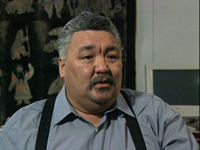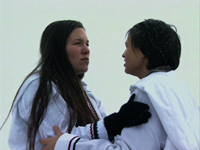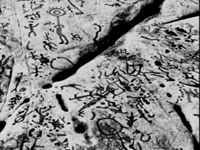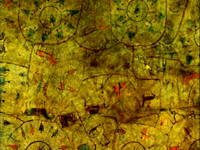Français
Finding Our Talk Season One
- Episode 1: Language Among the Skywalkers: Mohawk
- Episode 2: Language Immersion: Cree
- Episode 3: The Trees are Talking: Algonquin
- Episode 4: The Power of Words: Inuktitut
- Episode 5: Words Travel On Air: Attikamekw/Innu
- Episode 6: Language in the City: Ojibway/Anishinabe
- Episode 7: Getting Into Michif: Michif
- Episode 8 : Plains Talk: Saulteaux
- Episode 9: Breaking New Ground: Mi'kmaw
- Episode 10: A Silent Language: Huron/Wendat
- Episode 11: The Power of One: Innu
- Episode 12: Syllabics: Capturing Language: Cree
- Episode 13: A Remarkable Legacy: Saanich
Finding Our Talk Season Two
Finding Our Talk Season Three
Episode 12: Syllabics: Capturing the Language - Cree
In this episode, we look at the historical development and contemporary applications of syllabic writing systems among Native languages in Canada. Though conceived by missionaries and used by them to aid in bringing Christianity to the North, syllabics went on to play an important part in the spread of literacy through aboriginal communities, and continue to evolve in this direction today.
Background
 Writing systems evolved from the basic and common human need to communicate and to have the ideas and experiences of one’s culture recorded for posterity. Syllabics is a form of writing common to hundreds of languages worldwide. In Canada, a handful of aboriginal languages have evolved syllabic systems of writing.
Writing systems evolved from the basic and common human need to communicate and to have the ideas and experiences of one’s culture recorded for posterity. Syllabics is a form of writing common to hundreds of languages worldwide. In Canada, a handful of aboriginal languages have evolved syllabic systems of writing.
The earliest efforts in the development of syllabic systems for Amerindian languages were those of missionaries. A system devised for Ojibwe in Ontario by a Wesleyan minister, James Evans, in the 1840’s, proved the most enduring of these. Though his first efforts were cut short by Church authorities, he later applied his knowledge to Cree, with greater success. Evans became known as “the man who made birchbark talk”. Evans’ syllabic system was refined from an extremely economical form of shorthand, employing only 10 symbols. It has also been suggested that he borrowed from traditional Ojibwe symbols, found in samples of native embroidery and beadwork.
Roman Catholic and Anglican missionaries adopted the syllabic script for their translation work among the Indians. In 1861, the British and Foreign Bible society in London produced the entire Bible in Cree syllabics. To be sure, syllabics was favored as a way of disseminating the word of God, but native people also found their own uses for it. Indeed, many users of syllabic systems are profoundly attached to this method of writing and see it as part of their unique cultural heritage.
Today, three separate strands of syllabic writing exist, all derived and adapted from the Cree-Ojibwe system first developed by James Evans: Inuktitut, Cree (Algonquian family) and Dene (Athapascan family). The use of Déné syllabics among certain communities and languages (eg. Dalketh) has largely ended, and been replaced by more recent writing systems such as the Carrier Linguistic Writing System.
 Part 1
Part 1
The first segment of this episode traces the history of syllabics development, leading to present-day forms of Inuktitut and Cree writing. We begin with an overview of the work of James Evans, using extant books (hymnals and other religious texts) as well as correspondence, extracts of which will serve as a narrative voice-over. Gradually, we learn how syllabic writing became more complex through adaptations and refinements by subsequent missionaries working in Cree communities in Northern Québec and Ontario.
We also look at the development and spread of Inuktitut syllabics, which were adapted from the Cree system, by focusing on the life and work of the Rev. Edmund Peck. Peck came to Northern Quebec in 1876, charged with translating biblical material into Inuktitut syllabic script, promoting its use, and teaching reading and writing to the people. The Reverend Peck lived and worked in Northern Quebec and Baffin Island for almost 50 years.
In both cases, we use archival material, including photos, texts and documents, to evoke this period of syllabic development and spread through the North. Extracts from an interview with Josie Kusugak, current President of Inuit Tapirisat Canada and a former language language teacher and specialist, counterpoints the archival material with thoughts on the role of syllabics in spreading literacy to native communities, and also in displacing the more established oral tradition.
 Part 2
Part 2
If, in most First Nations communities, the spread of literacy went hand in hand with that of religion, today, the use of syllabics is widespread. Government documents, school materials, encyclopedias, newspapers, cultural magazines and other printed materials in common use are published using syllabic script. In this segment, we focus on the modern-day use and relevance of syllabics, in both Cree and Inuit contexts.
At a Cree School Board workshop, a group of dynamic women, educators and consultants representing all the Northern Québec Cree communities, demonstrate and discuss new curriculum materials for teaching syllabics. The women laugh together, engage in spirited debates about the value or relevance of particular projects, or work intently at their computers, correcting texts, or translating materials from one syllabic script to another. They also describe for us the particular features of syllabics that make it especially useful for their writing language.
Among the thorniest questions being dealt with today as regards the use of syllabics is that of its standardization, and the challenge of negotiating a common writing system between communities speaking different dialects. There are, for example, Coastal, Northern and Southern dialects in the 9 Cree communities of Northern Québec, as well as Eastern and Western dialects. Nunavut and Nunavik have different versions of Inuktitut, which in turn differ from those of Yukon, Alaska and Greenland. We discuss these issues with Josie Kusugak and Robbie Watt, who also address the relative merits of writing and the oral tradition in the preservation of culture and language.

